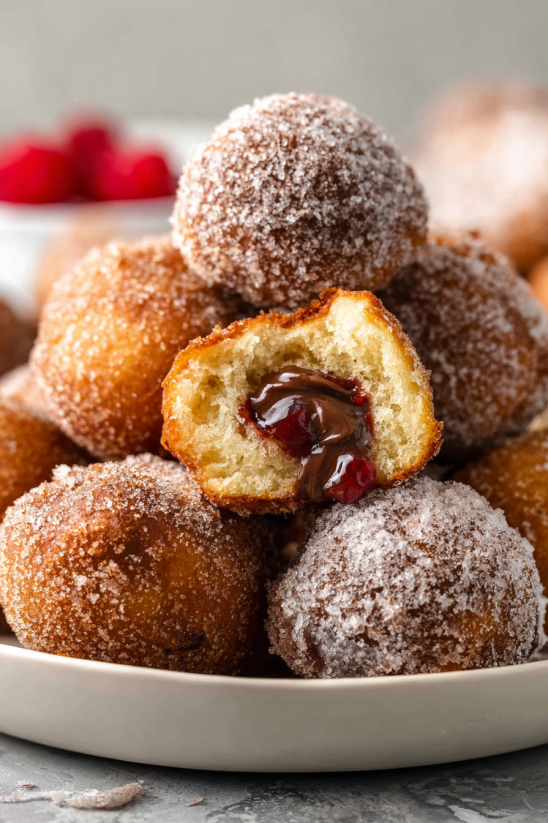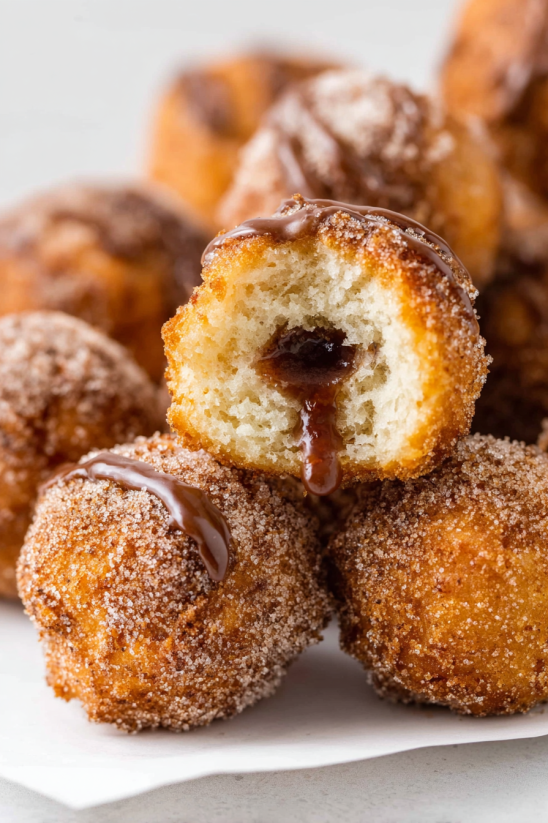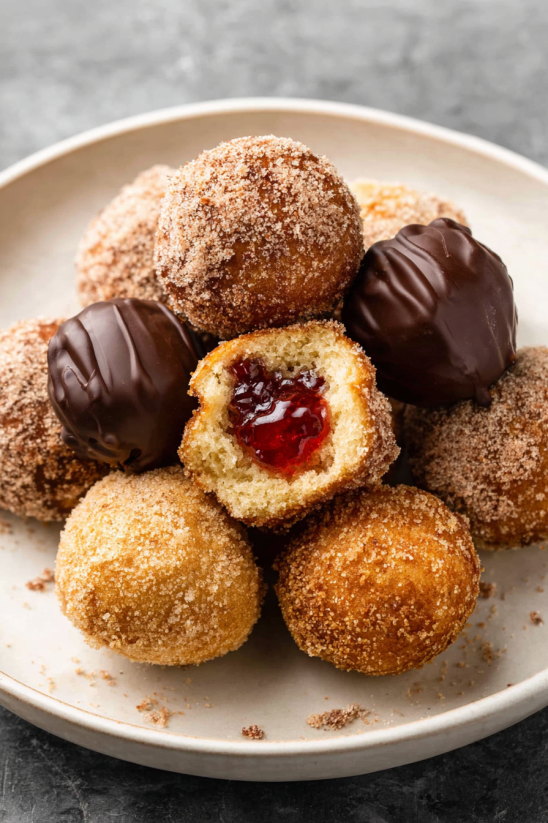 Save Pin
Save Pin
These homemade donut holes are my solution for an easy weekend treat when the donut craving strikes. Ready in twenty minutes from pantry basics, you mix up a no-yeast batter, fry, and coat with a sugar topping or glaze. My kids practically fight over who gets to dip the first warm donut hole in a pile of cinnamon sugar and I get to relive my childhood bakery visits every time I make them.
I first made these because my youngest always asked for store donuts but I wanted something quick and homemade. Now they are a must every time we have cousins visiting since the kids love customizing their toppings as much as eating them.
Ingredients
- All-purpose flour: scoop and level to keep the donut holes fluffy look for a bag with minimal bleaching for best flavor
- Baking powder: double check expiration date for the best rise I prefer aluminum-free versions
- Salt: brings out flavor in the dough use fine sea salt for even mixing
- Sugar: for light sweetness in the batter and rolling opt for organic granulated if available
- Cinnamon: optional adds a cozy spice if you want cinnamon sugar style try Vietnamese cinnamon for the brightest flavor
- Whole milk: makes the donuts moist and rich you can use two percent if that is all you have
- Egg: binds the dough and adds richness choose large eggs for consistency
- Oil: for frying select a neutral one with a high smoke point such as canola or vegetable
- Toppings: such as powdered sugar chocolate glaze jam or sprinkles these transform a plain donut hole into something fun there is no wrong choice
Step-by-Step Instructions
- Make the Batter:
- In a large bowl whisk together flour baking powder salt sugar and cinnamon if using. In a separate bowl whisk milk and egg until blended then pour wet ingredients into the dry. Mix gently with a wooden spoon until just combined so you do not develop the gluten. The batter will be sticky but avoid overmixing as this is the secret to tender donuts.
- Heat the Oil:
- Pour about two inches of oil into a heavy pot and clip on a thermometer. Heat slowly to between 360 and 375 degrees Fahrenheit. Keep the temperature in this range throughout frying which may mean adjusting your burner as you go.
- Scoop and Fry:
- Spray a small cookie scoop or two spoons with a little nonstick spray. Carefully scoop a round of batter and drop it straight into the hot oil. Only fry five to seven at a time to prevent lowering the oil temperature. Cook until the bottoms are a deep golden brown then turn to cook the other side. This usually takes two to three minutes per batch.
- Drain and Cool:
- Use a slotted spoon to transfer cooked donut holes onto a plate lined with paper towels. Let them sit a minute or two so the excess oil drains off and the donut holes cool slightly for glazing or powdering.
- Coat Top or Fill:
- While still warm roll the donut holes in cinnamon sugar if you want it to stick. For powdered sugar coating let the donut holes cool fully first so the sugar does not melt away. If filling with jam or Nutella use a piping bag to inject the center once cooled. Dip in glaze and add sprinkles right after so they adhere.
 Save Pin
Save Pin
The cinnamon sugar topping has always been my favorite and I love the little warm cloud of spice when biting into a fresh donut. The first time my daughter helped toss them in sugar she declared it her new favorite kitchen job and I have not gotten to roll one since.
Storage Tips
Donut holes are best eaten fresh but any extras can be stored in an airtight container at room temperature for up to two days. If you need to make them ahead of time or have many leftovers freeze them in a freezer bag for up to two months. Thaw at room temperature and warm briefly in the microwave to revive their softness. Glazed donuts do not freeze well since the glaze can weep so coat only right before eating.
Ingredient Substitutions
You can swap the whole milk for two percent or even a mixture of evaporated milk and water for good results. Almond milk can work if you need non-dairy but the flavor and texture will be a bit different. For gluten-free needs use a one-to-one gluten-free flour blend but make sure your baking powder is also gluten-free. Flavor extracts such as vanilla or almond can add a new twist to the batter or glaze if you want to change it up.
Serving Suggestions
Serve donut holes stacked high on a platter for brunch or pile them into a paper cone for a nostalgic snack cart vibe. Offer small bowls of different toppings for dipping so everyone can personalize. For parties or sleepovers let kids fill their own with jelly or chocolate and dip in colorful sprinkles. Leftover donut holes can also be sliced and layered in a parfait with whipped cream and fruit for a fun dessert.
 Save Pin
Save Pin
Donut Holes Around the World
While these are inspired by classic American donut shop holes every country has its take on fried sweet dough. Spain has buñuelos Italy has castagnole and India has sweet gulab jamun. The idea of a hot sweet dough bite is universal which is probably why this recipe makes so many people happy even on an ordinary morning.
Commonly Asked Questions
- → Do I need yeast for these donut holes?
No yeast is required; baking powder acts as the leavener, so there's no rising time needed.
- → Can I bake instead of fry?
These are best fried, as the batter is designed for frying. Baking won't produce the same round, fluffy texture.
- → How can I customize the flavors?
Roll in cinnamon or powdered sugar, fill with your favorite jam, or glaze with chocolate, maple, or fruit toppings.
- → What's the best oil for frying?
Use a neutral oil with a high smoke point, such as vegetable, corn, or canola oil, heated to 360–375°F for best results.
- → How should I store leftovers?
Store in an airtight container at room temperature for up to 2 days, or freeze for longer storage. Fresh is always best.
- → Can I make the batter ahead?
You can prepare the batter up to 24 hours in advance and keep it refrigerated, frying when ready.
